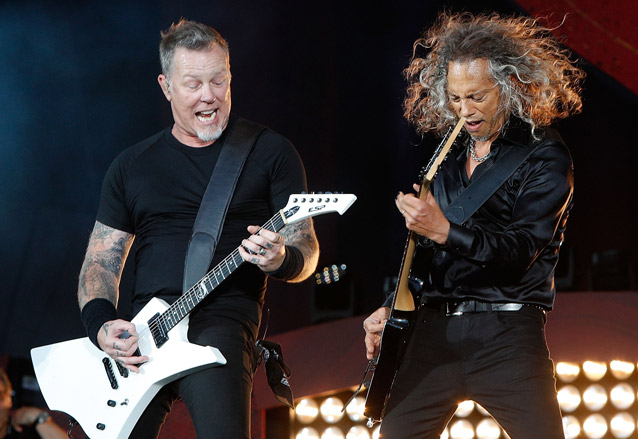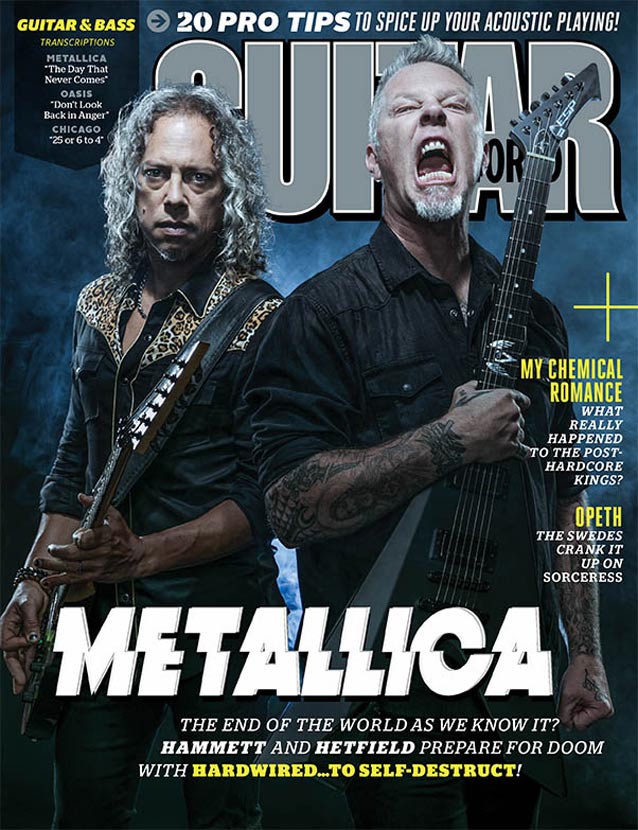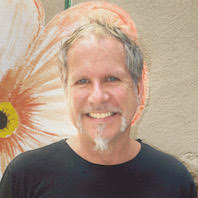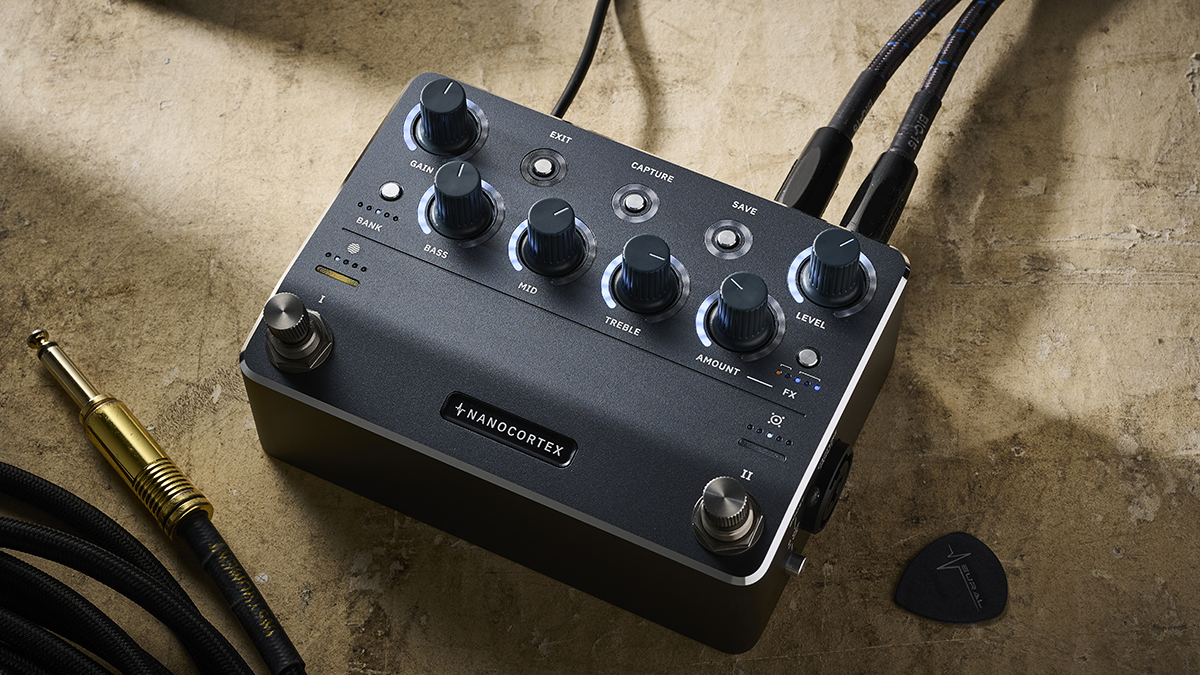Metallica's James Hetfield and Kirk Hammett Talk 'Hardwired,' Buddy Guy and Jimi Hendrix

“We’re so fucked!” bellows James Hetfield over the opening track of Metallica’s first album in eight years.
It’s a pretty harsh way to say “howdy do” after such a long absence, but most metal fans would probably agree a pissed James Hetfield is a good James Hetfield.
And on Hardwired…to Self-Destruct the thrash icon is none too happy. Over 12 lengthy songs, spanning two discs, Metallica’s chief songwriter rages like an angry bull about the crummy state of mankind, even summoning the mythical beast Cthulhu to destroy the Earth “as the world dies screaming.”
His fury on Hardwired is undeniable, but in person the 53-year-old singer is pretty chill. With his mellow West Coast drawl and thoughtful responses Hetfield seems like one cool cat. After speaking with him for a while, however, you start to notice his dry, sardonic chuckle. A-heh-heh-heh. It’s a small laugh, but it radiates an undercurrent of menace that he often uses to punctuate his bleakest observations. It’s the kind of chuckle you might hear seconds before getting hit in the head with a wrench in a dark alley.
Dressed in various shades of motorcycle black with patches of gray sneaking into his sandy hair, Hetfield’s a bit meatier than in past years, but it looks good on him. He might not be the guy that would start a barroom brawl, but with the extra weight it’s certainly believable he could finish it. When asked about the pessimism expressed on the song “Hardwired,” and to some degree, the entire album, the question is greeted with that laugh. A-heh-heh-heh.
“Yeah, we’re so fucked,” he says, savoring the words for a minute. “ ‘Hardwired’ is the first song on the album, but it was actually the last song we wrote. In my mind, it’s more of a summary of the whole album than an opening statement. Lyrically, I wanted it to be really simple, fast, quick and punk rock. The idea is to make it communal. You know, we’re fucked. All of us. But we’re blessed as well, because we’re all in this together.”
While those sentiments are not exactly “Give Peace a Chance,” it is mildly endearing that Hetfied has visions of his audience holding hands Kumbaya-style while singing lyrics like “we’re so fucked, shit outta luck.” Lead guitarist Kirk Hammett provides a stark contrast to the mighty Het. While James speaks with steady deliberation, Hammett delivers his ideas in the high-speed cadences of one of his guitar solos. Where Hetfield believes we are set “to self-destruct,” Hammett is a ball of positivity. He looks remarkably young as well. Except for those strands of silver and gray that now lace his corkscrew hair, you’d never have a clue that he’s also in his fifties.
All the latest guitar news, interviews, lessons, reviews, deals and more, direct to your inbox!
The guitarist attributes at least some of his healthy glow to his new lifestyle. “I feel like I’ve just turned another corner,” he says. “I’ve reconnected with my instrument in a way I never have before. I quit drinking, which changed things. On nights we had shows, I’d play the gig, go out afterward and get drunk, and then go back to my room and play for a couple hours. I still do that, but the big difference is I don’t drink anymore and I retain what I played the next day. These days I feel I can play anything that I really set my mind to, whether it’s Paganini or a jazz standard. It might take me a couple weeks, but I can do it!”
Enjoy this excerpt from the Holiday 2016 issue of Guitar World. For the full interview, check out the new issue of Guitar World.
I really like that fact that you broke the album into two discs. It feels more like vinyl in a way. It’s sort of Side A and Side B.
JAMES HETFIELD When we’re writing songs, we don’t think about whether it’s going to fit on one CD, it’s more about variety and trying to capture every aspect of what we do. We just had too much music to fit on one disc, so we put it on two. We didn’t really think about it being like vinyl, but I get where you’re coming from.
After the experimentation of albums like Lulu and St. Anger, it feels like between Death Magnetic and Hardwired…to Self-Destruct you’ve settled on a new sound that really works for the band.
HETFIELD I’m always looking for our sound. Sometimes I’m not sure if we have one! We’re always trying to evolve into something better. We thought St. Anger was better, but sonically it was too harsh for some people. That album was feral…very feral. Perhaps the connection you’re hearing between Hardwired and Death Magnetic is that Greg Fidelman engineered both.
It’s a bit more than that. The arrangements are streamlined in similar ways and both are in standard tuning, which is rare for a metal band these days. They both have almost a high-octane rockabilly element to them.
KIRK HAMMETT I see what you’re saying. A lot of this record is sort of mutant boogie-woogie from the depths of hell with oil and gravel all over it! I’d say the riffs are overall more simple and groove-oriented. It has a high energy, mischievous feel. Whenever I play “Hardwired” and we go into that second riff, I love it because it sounds so reckless, but we’re completely in control.
HETFIELD Yes, in some ways they’re a bit like the early records. Playing in standard tuning gives both albums a more youthful and urgent feel that drop tuning doesn’t have. We drop live, which makes our sound heavier and easier for my vocals, but the show provides the energy. On a record, standard tuning lifts it and adds excitement.
Kirk, when I listened to your playing on this album I was reminded of fearless improvisers like Jimi Hendrix, John McLaughlin and even bluesman Buddy Guy. Was that the mission?
HAMMETT Well, you’re about 98 percent on the money, especially about Buddy Guy. I saw him at a club about three weeks ago, he’s about 80 years old and he can still play his ass off! The first time I saw Buddy was years ago, though. I thought, Wow, he’s like the Yngwie of blues! There was a point in his career in the late Eighties and early Nineties that he was just burning it up. He was playing these crazy 32nd-note runs in a blues context, which was pretty rare for a guy that’s been around since the Fifties. I always admired his recklessness, the attitude and even the mistakes. One of my favorite recent finds is this video of Buddy playing in a Greenwich Village club around ’68 [Watch it below]. Hendrix is in the audience, and Buddy is in the zone. He’s sweating, going crazy and suddenly he breaks a string on his Strat. The guitar goes completely out of tune, but he keeps going. The commitment is there and the feeling just comes through regardless. It kills me every time I watch it.
Jimi once said, “Heaven is lying at Buddy Guy’s feet while listening to him play guitar.”
HAMMETT Yes! I was trying to channel some of that energy. There were times on this album where I was pushing my technique to the point that I felt I was just a spectator, and the notes were really surprising and weird. I love that sense of excitement and unruliness. It also appeals to me because these days it seems like there are two schools: one that focuses on precision and the other that doesn’t care at all. I’m trying to occupy a space that takes advantage of both worlds, which is different.
That feeling existed in the early days of jazz-fusion before it became sterile. Guys like John McLaughlin in Mahavishu Orchestra or Bill Connor in Return to Forever were playing in a way that was required technique, and an intimate knowledge of theory but were improvising with a fire.
HAMMETT In the late Sixties and early Seventies what made fusion so good was the intelligence of jazz meeting in a full-on collision with the rawness of rock. But unfortunately, players on both sides of the spectrum started to clean up all their licks and fusion lost that special edge.
The new album is split in two physically, but is it split thematically?
HETFIELD Not really. The order of the songs on our albums is usually more driven by the music than how the lyrics move. I don’t think we’d construct something like Side One is “we’re fucked” and Side Two is “here’s the light at the end of the tunnel.”
I did feel that the first album was more about fear and the second was about taking action.
HETFIELD That wasn’t intentional, but that’s not far from how I actually feel about things. Sometimes I feel doomed and other times I think, What am I worried about? This is supposed to happen. Let’s get on with it.
On the song “Atlas, Rise,” you mock those that have the audacity to think they can solve the world’s problems by themselves. Who is that person?
HETFIELD The song started as a question I was asking myself: Why do you think the weight of world is on your shoulders? It’s about the part of man that wants to be a martyr. The part that thinks, If I don’t do this, everything is going to fall apart. But you know, maybe not. You may have less control than you think you do. I think we’re all held hostage by that feeling some point in our lives. It’s a common thing. Call me a cynic, but do you really think you’re going to save the whales? Do you think you can really clean up all the pollution in the world? Those are good intentions, but if you’re more concerned about saving a red-legged frog from extinction than taking care of someone in your own family, you’ve got a problem. “Atlas, Rise” is about losing perspective.
I saw the character as being Trump-like. Someone who thinks they can actually make America great again all by themselves. I can appreciate the thought, but…
HETFIELD Yeah, having confidence that any politician can solve everyone’s problems is ludicrous. It’s like when countries are ruled by dictators. The people cry, “This is our savior!” And the savior ends up stealing their money, and the people are left asking, “What the fuck?” [laughs].
For the full interview, check out the Holiday 2016 issue of Guitar World.

A long time ago in a galaxy far, far away Brad was the editor of Guitar World from 1990 to 2015. Since his departure he has authored Eruption: Conversations with Eddie Van Halen, Light & Shade: Conversations with Jimmy Page and Play it Loud: An Epic History of the Style, Sound & Revolution of the Electric Guitar, which was the inspiration for the Play It Loud exhibition at the Metropolitan Museum of Art in New York City in 2019.

